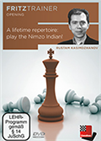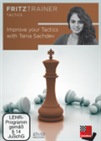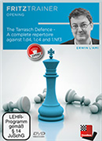Six GMs are three for three
The third round of the Abu Dhabi masters came to a close on Thursday evening, heading into the tournament's only rest day Friday with six players managing to remain at the top of the leaderboard. Out of the five grandmasters rated above 2700, only two — Richard Rapport and Wang Hao — were able to retain their perfect score. Daniil Dubov, Amin Bassem, Martyn Kravtsiv and Daniele Vocaturo also won their third consecutive games to join Rapport and Wang at the top.
Round 1
The initial rounds of strong open tournaments like this one are always exciting. Norm-hungry title aspirants fight to their fullest and, many a time succeed in knocking their high rated opponents off their pedestals.
In that regard, the inaugural round was quite a spectacle. The top seed of the tournament, GM Le Quang Liem was thoroughly outplayed by V S Rathanvel, a 17-year-old FIDE Master from India. With an Elo of 2348, Rathanvel was rated almost 400 points below the Vietnamese number one.
Le has been in top form lately. He has come to Abu Dhabi after a very successful outing in Dangzhou where he finished clear second in an all 2700+ rated eight-player round-robin, winning back to back games in the last two rounds. But this game painted a completely different picture.
 The Caro Kann is a very tricky opening. Black’s play is based on controlling and fighting for key light squares. It is a line which was very fashionable in late 90s and early 2000s due to the successes of greats like Karpov, Anand, Dreev etc. Recently due to strong engines lot of key developments have been made and some new lines have been introduced, while others have been refuted altogether. I have analyzed the new trends carefully and found some new ideas for Black.
The Caro Kann is a very tricky opening. Black’s play is based on controlling and fighting for key light squares. It is a line which was very fashionable in late 90s and early 2000s due to the successes of greats like Karpov, Anand, Dreev etc. Recently due to strong engines lot of key developments have been made and some new lines have been introduced, while others have been refuted altogether. I have analyzed the new trends carefully and found some new ideas for Black.
If one were asked to guess who was playing white in the game, one might easily fall prey to thinking it was Le Quang Liem. In a Caro-Kann Advanced, Le had established a menacing pawn on d3. In the position above, it is black to play and taking on a1 with the queen or on e5 with the knight were decent options.
However, Black played 17…Bg4, perhaps, trying to dislocate the d1 rook. If White moves the rook to e1, Qxa1 just wins. White does not have Bb2 in this case as the rook on e1 remains en prise. But Rathanvel never intended to defend the rook. He simply responded with 18.Bb2 and after 18…Bxd1 19.Rxd1 Qg4 20.Rxd3 Rd8, planted his knight in the heart of black’s position with 21.Nd6. Play turned extremely sharp after this and Rathanvel proved that his tactical skills are absolutely world class!

17-year-old VS Rathanvel managed to upset the top seed of the tournament, Le Quang Liem, in the inaugural round | Photo: Abu Dhabi Masters Twitter
Another astounding development took place in the game between Salem Saleh and Sankalp Gupta. Saleh had dominated all through the game and by the 36th move, he was merely giving finishing touches to his well-deserved victory when an unfortunate mishap ruined it all.
Black is very passive here. The bishop has no future and the rook is stuck defending it. Saleh simply gave up an exchange here with 36.Rxb7 and was just completely winning. But then the Emirati grandmaster began to move back and forth with his queen. At first, it looked like Saleh was just playing cat and mouse with his opponent but, as it turned out, he had lost the thread of the position and ended up being held to a draw!

GM Salem Saleh shockingly drew a winning game against Sankalp Gupta| Photo: Abu Dhabi Masters Twitter
 Let FIDE Senior Trainer and IM Andrew Martin introduce you to the Tiviakov method, where he covers all of 8.b3, 8.Re1, 8.Bf4, 8.Bg5, 8.a3, 8.Qa4 and 8.d5 and all in around an hour!
Let FIDE Senior Trainer and IM Andrew Martin introduce you to the Tiviakov method, where he covers all of 8.b3, 8.Re1, 8.Bf4, 8.Bg5, 8.a3, 8.Qa4 and 8.d5 and all in around an hour!Something equally stunning and surprisingly similar was seen in the game between Koustav Chatterjee and GM Sanan Sjugirov. Just like in the game between Saleh and Gupta, an exchange was sacrificed on the 36th move. But this time it was black who had played the sac.
Sjugirov plunged in here with 36…Rxf3 37.gxf3 and 37…Qh2+. After this, White was completely winning. It’s not clear whether this was time pressure or something else but both players missed several opportunities after this. Within six moves, White, from being completely lost, was in a totally winning position. But surprise, surprise… a draw was agreed!!

Koustav Chatterjee held GM Sanan Sjuigirov to a draw in a topsy-turvy battle | Photo: Amruta Mokal
Round 2
In round two, Richard Rapport won in his trademark style against Dinara Saduakassova on the top board. From the white side of a Classical Nimzo-Indian Defence, the Kazakhstani WGM came up with a novelty early in the game and then castled on the queen’s wing signalling a full-blooded fight. And Richard being Richard, was only glad to oblige. On his 13th turn, he simply offered a bishop to castle short.
 This DVD provides everything you need to know to be able to play one of the most classical openings with Black, the Nimzo-Indian, arising after 1.d4 Nf6 2.c4 e6 3.Nc3 Bb4. Nearly every World Championship and top tournament features the Nimzo-Indian.
This DVD provides everything you need to know to be able to play one of the most classical openings with Black, the Nimzo-Indian, arising after 1.d4 Nf6 2.c4 e6 3.Nc3 Bb4. Nearly every World Championship and top tournament features the Nimzo-Indian.
This position is simply beyond muggle comprehension. It’s not quite clear how black will achieve anything tangible in this position if the bishop is captured. Sure, he has the initiative and white is passive but fact remains that black is a piece down. The computer also calls it even for several moves after the sac but nothing concrete is reached. Saduakassova declined the sacrifice, however, and tucked her king into safety with 13.Kb1. A few tricks later, the following position was reached.
Twenty moves had been played so far and both players had gone wild to their heart’s content. At the moment, White is a full rook down. Of course, White can collect the h1 knight and keep a decent position. But quite apparently, that’s not Dinara’s style. She played 21.Qc5 here, with a very specific trick in mind. Black rescued his knight with 21…Nf2 and white went 22.Qe7.
 The aim of this course is to help you understand how to make tactical opportunities arise as well as to sharpen your tactical vision - these selected lectures will help to foster your overall tactical understanding.
The aim of this course is to help you understand how to make tactical opportunities arise as well as to sharpen your tactical vision - these selected lectures will help to foster your overall tactical understanding.
On the surface, it looks like black can’t avoid a queen exchange since if he moves his queen away 23.Qxf8 leads to an instant mate. Richard agreed with this evaluation and exchanged queens here, missing the strong refutation, 22…Bf5+! Nevertheless, he was still better after the game continuation 22…Qxe7 23.Nxe7+ Kh8 24.Rd2 Rb8.
It’s time for white to take the f2 knight now, either directly or after 25.Nc6 Rb6. In either case, white is worse. Instead, Saduakassova decided to seek counterplay here with c6-c6-c7. But this was a bit too far-fetched. Rapport wrapped the game up soon after this.

Dinara Saduakassova decided to take the bull by the horns and played a sharp line against Richard Rapport | Photo: Abu Dhabi Chess Festival Twitter
The game on board 16 in round two featured quite a surprising blunder. GM Abhijeet Gupta was pitted against the Uzbek IM Gunay Mammadzada and was caught by shock in the middle game.
 Are you looking for an active defence against 1.d4? Look no further! The Tarrasch Defence (1.d4 d5 2.c4 e6 3.Nc3 c5) is one of Black's most ambitious ways to meet 1.d4.
Are you looking for an active defence against 1.d4? Look no further! The Tarrasch Defence (1.d4 d5 2.c4 e6 3.Nc3 c5) is one of Black's most ambitious ways to meet 1.d4.Mammadzada had a slight edge in the game having sacrificed a pawn in the Tarrasch variation of the French when Abhijeet made a fatal error. On his 21st turn, he went with his knight to a5 and that spelt doom for the Delhi based GM.
Mammadzada responded with the refutation 22.Nb3. After black took the rook with 22…Nxb7, white simply recaptured with 23.Bxb7, leaving Black with both his rook and bishop en prise. Gupta tried the desperado 23…Bxf2 but soon White’s extra material made itself count.

GM Abhijeet Gupta's miscalculation lost him the full point | Photo: Niklesh Jain
Round 3
The third round saw Richard Rapport pull a rabbit out of the hat yet again. For the second time in the tournament, he had put his faith in the closed Sicilian with the white pieces in his game against Mads Andersen. Rapport tried hard to get something to bite on in the game but Andersen ensured that the position never went out of control. After the smoke had cleared, the players found themselves in a rook endgame where it was, in fact, Rapport who was a pawn down.
The endgame is just dead equal. Play continued 37.Kf2 g5 38.Rc6 gxh4 39.gxh4 Kh7. Now, 39…Kg7 would have kept equality but in moving the king to h7, black had an ambitious plan.
After 40.Kf3, black went Rg7 and Rg4, trying to create an outside passer. As it turned out, this was a bit too ambitious. White sought counterplay in his own central passer and white's e-pawn was much faster.

Richard Rapport benefitted from his opponent's over-ambitious play | Photo: Lennart Ootes
On board three Wang Hao had the white pieces against SL Narayanan of India. The two discussed the Archangelsk variation of the Ruy Lopez in which Narayanan managed to bury White’s light-squared bishop completely out of play in b1. However, in doing so, he had also weakened his queenside pawns.
Here, Wang went to grab the b5 pawn with 21.Ra5. In response, Narayanan correct countered in the centre with 21…d5. But after 22.Rxb5, the Indian GM faltered and played 22…fxe4 and remained down a pawn after 23.Bc5 Qe8 24.Rxb8 Rxb8 25.fxe4.
Narayanan could have kept things under control had he gone straight for the rook exchange with 22…Rxb5 23.Nxb5 and 23…Qb7. The game continuation, however, gave white a strong edge. White was eventually able to collect the c4 pawn as well and his queenside majority soon decided the day.
Standings after round 3 (top 20)
All games
Links
























